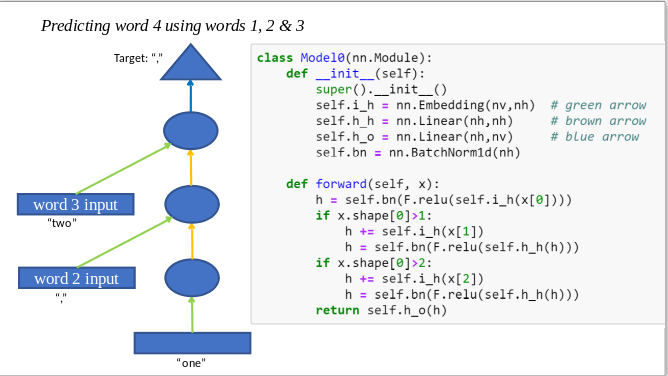Hi All
I have a question regarding Model0 in 6-rnn-english-numbers(https://github.com/fastai/course-nlp/blob/master/6-rnn-english-numbers.ipynb) notebook. I couldn’t find a category for course_nlp so I used the Part 2 (2019) category.
In the notebook Model0 class is defined like so -
class Model0(nn.Module):
def __init__(self):
super().__init__()
self.i_h = nn.Embedding(nv,nh) # green arrow; nv=40; nh=64
self.h_h = nn.Linear(nh,nh) # brown arrow
self.h_o = nn.Linear(nh,nv) # blue arrow
self.bn = nn.BatchNorm1d(nh)
def forward(self, x): # x.shape (64, 3)
h = self.bn(F.relu(self.i_h(x[:,0])))
if x.shape[1]>1:
h = h + self.i_h(x[:,1])
h = self.bn(F.relu(self.h_h(h)))
if x.shape[1]>2:
h = h + self.i_h(x[:,2])
h = self.bn(F.relu(self.h_h(h)))
return self.h_o(h)
Based on this image from https://github.com/fastai/course-nlp/blob/master/RNNs.pptx(slide 5)
 shouldn’t the model class be defined as -
shouldn’t the model class be defined as -
class Model00(nn.Module):
def __init__(self):
super().__init__()
self.i_h = nn.Embedding(nv,nh) # green arrow; nv=40; nh=64
self.h_h = nn.Linear(nh,nh) # brown arrow
self.h_o = nn.Linear(nh,nv) # blue arrow
self.bn = nn.BatchNorm1d(nh)
def forward(self, x): # x.shape (64, 3)
h = self.bn(F.relu(self.i_h(x[:,0])))
if x.shape[1]>1:
h = self.h_h(h) + self.i_h(x[:,1]) #brown arrow + green arrow for word 2
h = self.bn(F.relu(h))
if x.shape[1]>2:
h = self.h_h(h) + self.i_h(x[:,2])
h = self.bn(F.relu(h))
return self.h_o(h)
What am I missing here or not understanding correctly?